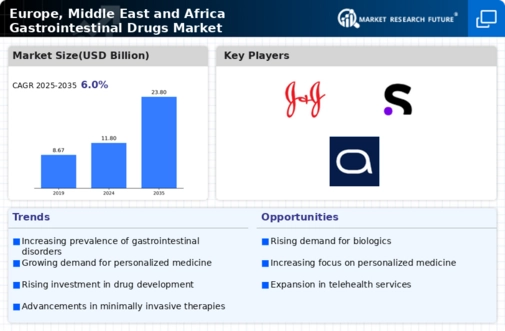Market Analysis
In-depth Analysis of Europe Gastrointestinal Drugs Market Industry Landscape
The intricate interaction of variables influencing the demand, supply, and total growth of the pharmaceutical industry is reflected in the market dynamics of gastrointestinal medications in the Europe, Middle East, and Africa (EMEA) region. Market Size and Growth: Due to the rising incidence of gastrointestinal illnesses in the area, the market for gastrointestinal medications in EMEA has grown significantly in recent years. The market is growing, and there is a discernible increase in the need for efficient treatment alternatives. Disease Prevalence and Demographics: In the EMEA area, there is an increase in the prevalence of gastrointestinal illnesses, such as irritable bowel syndrome, gastric reflux disease, and inflammatory bowel disease. This increase is linked to variables including food preferences, aging populations, and changing lifestyles, which increase the number of patients in need of pharmacological treatments. The gastrointestinal medicines industry is subject to major changes influenced by the regulatory landscape. Tight laws and lengthy clearance procedures affect new medication launches, reshaping the industry and pharmaceutical firms' approaches to market share in the area. Competitive Landscape: Well-established pharmaceutical businesses are in fierce competition with one another for market share, which defines the market. There is a fierce rivalry as businesses concentrate on R&D to launch novel medications that meet unmet medical requirements. Market Trends and Innovations: The EMEA gastrointestinal medicines market is being shaped by ongoing developments in drug development, such as the introduction of biologics and targeted treatments. Improvements in patient compliance and treatment results are a result of innovations in medication delivery techniques and formulations. Healthcare Infrastructure: A key factor in affecting market dynamics is the caliber and accessibility of the healthcare infrastructure. Gastrointestinal medicine adoption rates are impacted by variations in healthcare systems throughout EMEA nations; variances in pricing and accessibility influence market expansion. Economic Factors: Market dynamics are influenced by a number of economic factors, such as healthcare expenditure, reimbursement practices, and general economic stability. The accessibility of gastrointestinal medications is determined by factors such as affordability and insurance coverage, which influence market penetration. Emerging Markets: The pharmaceutical industry, which includes gastrointestinal medications, is growing as the economies of the Middle East and Africa continue to flourish. Market participants can take advantage of emerging markets to capitalize on expanding populations and unmet medical requirements.






Leave a Comment